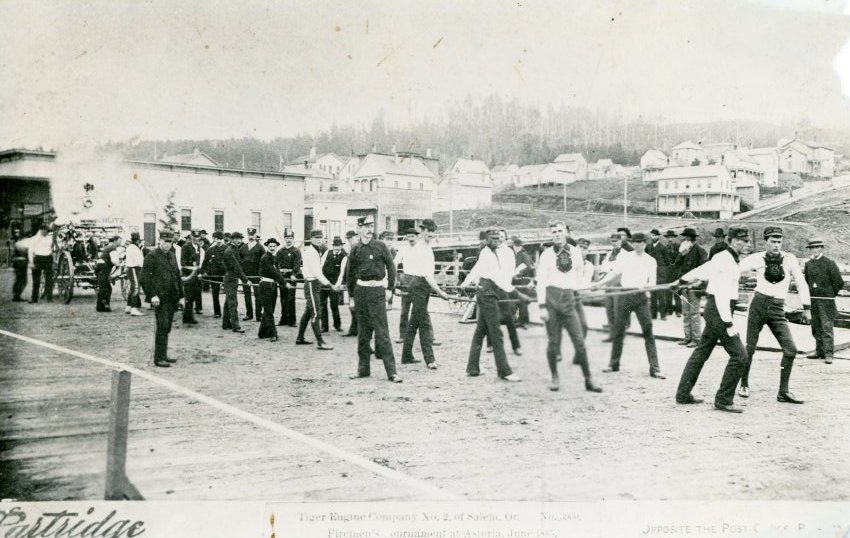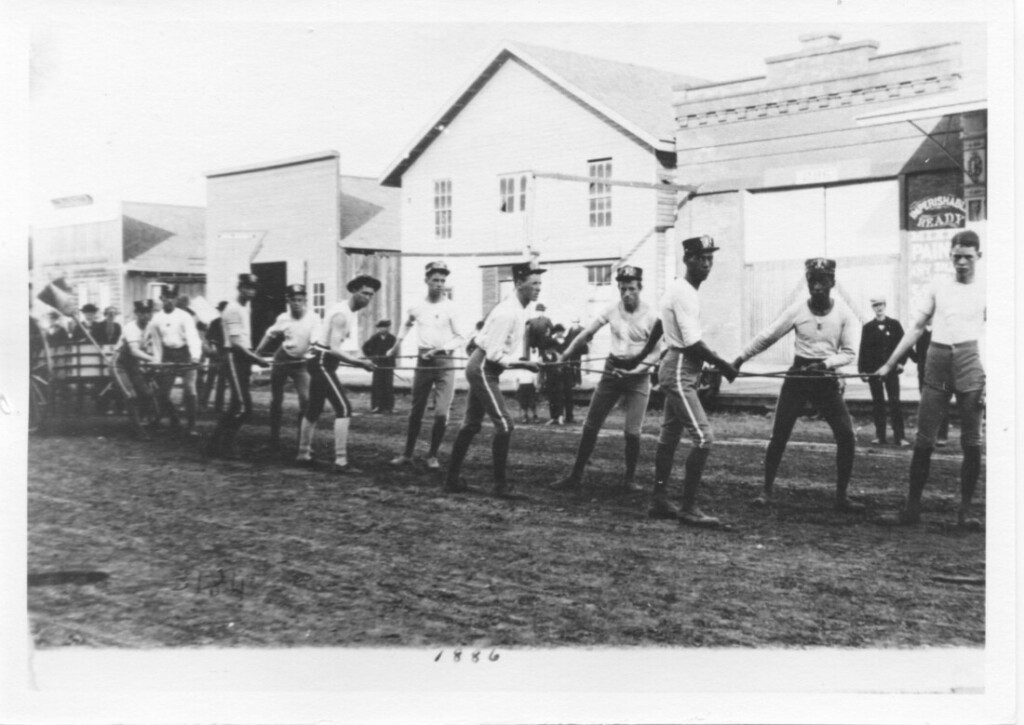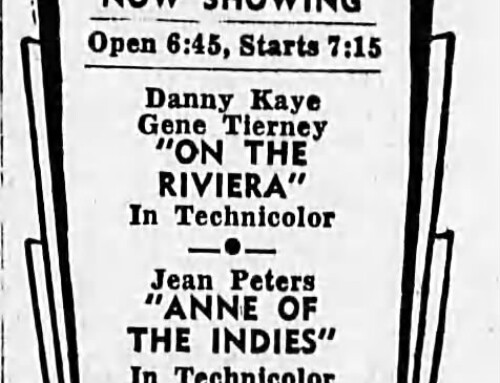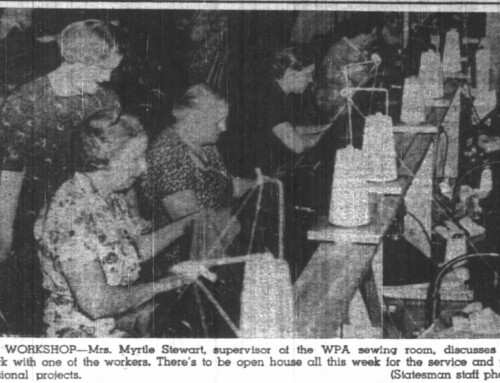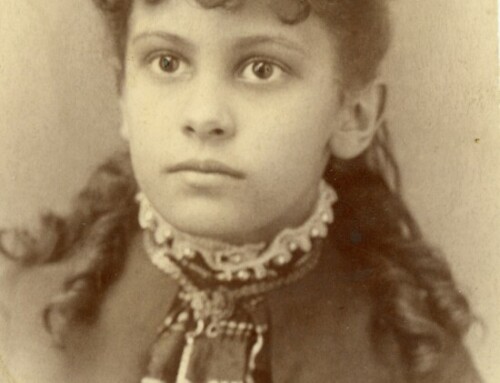For the past few years I have been captivated by this photograph. It shows the Salem-based Tiger Fire Company No. 2 in action, competing in a fireman’s tournament in Astoria in 1885. The tall African American man in the center particularly caught my imagination. In a state that technically had laws on its books (although rarely enforced) forbidding African Americans from residing here or owning property until 1926 and with the reputation of being a hotbed for the Ku Klux Klan and other discriminatory practices, it was both surprising and encouraging to see this man as part of this team. It also raised a lot of questions. What was this experience like for him? Did he feel accepted into this community of firefighters? Who was he?
The individuals in the photograph are not labeled and I had all but given up hope of identifying him until I started doing some research for the Salem Fire Department’s 160th anniversary exhibit, which will opened to the public at the Willamette Heritage Center in November, 2017. In the Willamette Heritage Center’s collections we have a ledger that shows the membership rolls of all of the volunteer fire companies in the cit. Volunteers made up the majority of the Salem Fire Department until 1893. I started thinking back to that photo. Perhaps if I cross-referenced the membership rolls with Salem’s small African American community listed in the 1880 census I could narrow down the possibilities of who this gentleman was? Turns out one name matched: Frank Gorman.
Now I should probably lead with a caveat that just finding the name on the list isn’t conclusive proof that the man in the photograph is Frank Gorman [See Update Section below]. However it is a tantalizing clue that seems to fit the evidence. The membership record shows that a Frank Gorman joined the Tiger Fire Company No. 2 on May 14, 1884 and served until June 12, 1889, a time span that includes the year the Astoria photograph was taken.[1] There are only two F. Gorman’s listed in the 1880 Census in Salem, both are African American and I believe they are the same person enumerated twice.
The Gorman Family
Frank Gorman was born into slavery in Missouri around 1861. His journey to Oregon may be as surprising as his photograph. Frank’s grandmother, Hannah Gorman, was the first to come west, traveling over the Oregon Trail in 1844 as a slave of John Thorp. She and her daughter Eliza settled with the Thorp family in Polk County, southeast of Independence.[2] When Hannah left Missouri, she left behind a son named Hiram (Frank’s father) who was only about 10 years old at the time.[3] What little of Hiram’s early life we know comes from his obituary. It says he was set free by the Emancipation Proclamation in 1865, but before that he “was attached to the Union forces as a teamster, and was present at the battle of Wilson Creek, where he saw General Lyon killed while leading a charge.”[4] In about 1865, Hiram moved his family to Montana where two more children (Emma and William) were born and Hiram worked as a ranch hand.[5] By 1871, the family had moved to Salem, where Hiram ran the printing presses at the Oregon Statesman newspaper for 12 years. He was eventually replaced by mechanization when the Statesman bough a steam press.[6]
Why did the family settle in Salem? There is no clear-cut evidence, but I can’t help but think that Hiram was looking for his mother. We know they were reunited. Hannah’s obituary notes that she was staying Hiram in Salem when she died in 1888. What would that reunion have been like after decades of being nearly a continent apart? How did Hiram find her? It doesn’t appear that either Hiram or Hannah could read or write. Census records continually list Hannah as not being able and in her probate case file Hiram signs a document with an “x.” Hannah had been living in Corvallis and Portland by the time Hiram and his family moved to Salem. It is all pretty amazing.
One more interesting note about Hannah. By virtue of coming to Oregon, Hannah and her daughter Eliza were freed from slavery much earlier than Hiram. While not completely straightforward in the application, Oregon technically outlawed slavery in 1843. It appears however that Hannah and Eliza lived with their former masters until at least 1850. They then moved to Corvallis where they worked as a laundress and seamstress. They did well for themselves, saving enough money to purchase land and a home in 1857. The house still stands today at 641 NW 4th Street and was recently added to the National Register of Historic Places.
Frank’s story takes a turn for the worse. After several run-ins with the law, he eventually is charged with assault with a deadly weapon after he allegedly attacked a co-worker with a wrench. The motivation for the crime is described as revenge mixed with whiskey. The co-worker supposedly got him sacked from his job after informing a supervisor that Frank mistreated a team he was driving. Frank served 2 years of a five-year sentence at the Oregon State Penitentiary before being pardoned by Governor Sylvester Pennoyer claiming sufficient punishment had been meted out. Frank’s trail goes cold at this stage. There is a Frank Gorman living in Salem and working as a driver in the 1893 Salem City Directory, but he does not appear in the 1895 Marion County census. It looks like he may have followed his sister and mother to Kansas as there is a George F. Gorman living in Kansas City (his official booking records in to the Oregon State Penitentiary list his given name as George Frank Gorman). Like the photograph, however, it is difficult to determine if this is indeed the same individual. Frank’s life will likely remain shrouded in a bit of mystery.
This article was written by Kylie Pine appeared in the Statesman Journal newspaper in November 2017. It is reproduced here with citations for reference purposes and with additional information found since publication below.
Update
Since the writing of the above, this photograph has come to light. It appears printed in the Capital Journal newspaper on Saturday, February 16, 1946, pg 12, with the caption:
A broom over the cart proclaims this Tiger tender team winner of the firemen’s tournament staged in Salem in 1884. The picture is furnished the Capital Journal by former Governor Oswald West of Portland, who says the boy in the lead is Milt Thornton; the taller colored boy is George Bonter, and immediately behind him on the same rope is Jimmy Olinger. One column picture at left [referring to another image printed in the paper that day] is Olinger, a resident of Salem, as he appears today. He identifies others in the Tiger tender team as Carrol Moores, Frank Haas, Frank Starr, Billy Crawford and George Lawton. The tournament was held on Commercial Street. Mr. Olinger who lives at 1109 Mill Street, has been a resident of Salem since 1873.
This photograph may provide more questions than answers, but it does give another potential name: George Bonter. Could it be him in the Astoria Tournament? Could the unnamed African American man in this photograph by Frank Gorman?
George Bonter
George Allen Bonter was born in Salem, Oregon in 1868 [7] to Jackson Bonter, a painter, and Mary Parks Bonter[8]. By the time the 1885 photograph was taken in Astoria, he would have been 17 years old, and 20 in the Salem tournament photo above. An 1891 Salem City Directory shows him working as a porter and residing with his father at 9th Street at the SE corner of Shipping. By 1904, he shows up Voter Lists in San Francisco, California.[9] It may have been there that he met Adeline Lorenzo Cummings of that city, whom he married in Portland June 6, 1906.[10] George appears living in Salem and working as a porter and a janitor in the 1908 and 1909-1910 Polk’s Directories for Salem, but he and Adeline are enumerated in the 1910 US Census in Oakland, Alameda, California. The 1913-1915 Salem City Directories show the couple living in Salem again, George working as a Porter for the Marion Hotel. By the 1920 US Census, they are living in Portland, where he is working as a repair man in a garaged. By 1930, they are back in San Francisco. George Bonter died 25 Aug 1931 in California. [12]
Citations
[1] Willamette Heritage Center Collections No. 0082.002.0022
[2] Obituary. Oregon Statesman. 2 July 1888. 3:3. 1850 US Census, Polk County, Oregon (accessed via ancestry.com.)
[3] In the 1870 US Census (accessed via ancestry.com), Hiram is listed as 37 years old, giving and approximate birth date of 1833. In the 1880 US Census (accessed via ancestry.com) lists his age as 45, giving him an approximate birthdate of 1835.
[4] Obituary. Oregon Statesman. 24 July 1888 3:3.
[5] Obituary lists travel to Montana in 1865. Children Emma and William born 1865 and after are listed with birthplaces of Montana. 1870 US Federal Census accessed via ancestry.com. NB that the official census record lists the family with the last name of Blairns/Blevins. This has led to confusion in the past, but it seems highly unlikely that it is not this family. All the ages and names of the kids are right and fit the 1880 Census where they are living in Salem. I have no answer for why they were going by a different name at this time, but it appears that it is not a enumeration error, as there is a newspaper article from a Montana paper that lists Georgia Ann Blevins.
[6] Obituary. “Beat It” Oregon Statesman. 14 June 1871. establishes secondary source for Hiram’s move to Salem. Reads “Hiram Gorham, a colored individual, who lives at the corner of Liberty and Chemeketa Streets, brought to this office yesterday a pea stalk grown on his plantation, which measures seven feet and three inches in length.”
[7] See California Death Index (George A. Bonter); All Census entries (1930, 1920, 1910, 1880). His Multnomah County Marriage Record to Adeline L. Cummings in 1906 lists birthplace specifically as Salem, Ore.
[8] See US Federal Census for East Salem, Oregon 1880 listing parents. See also biographic section for Jackson “Jack” Bonter in Perseverance : a history of African Americans in Oregon’s Marion and Polk Counties. Salem, Ore: Oregon Black Pioneers, 2011, pp 32-36.
[9] California State Voter lists accessed via ancestry.com. George Allen Bonter, 36, 2 Lewis Place, first Floor.
[10] See GFO of Oregon’s Multnomah County Marriage Index, and also index card digitized via Ancestry.com.
[12] California Death Index. Accessed via Ancestry.com.
See the Tiger Fire Engine Company Membership Book
Click Here to see the names of members of the company and some digitized pages from the ledger in the WHC Collections.



